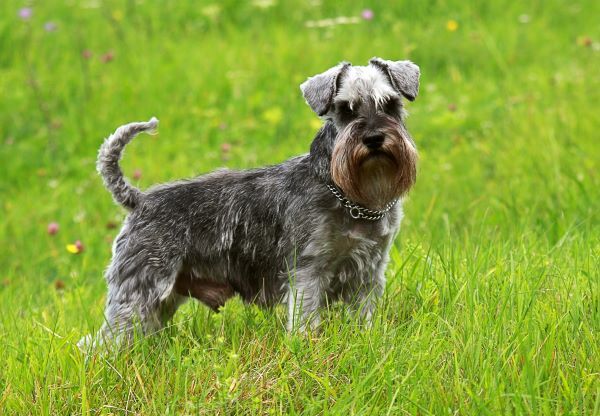Miniature Schnauzer


| Recommended for | Active households, families with children, first-time dog owners |
| Breed Classification | Terrier group |
| Other names | Mini Schnauzer |
| Lifespan | 12 to 15 years |
| Size | Small |
| Temperament | Friendly, alert, confident, loyal, playful |
| Intelligence | High; quick to learn |
| Tendency to bark | Moderate; they are alert and often vocal |
| Maintenance Level | Moderate grooming needs; regular trimming required for their wiry coat |
| Health Risk | This breed has an around average probability of having health issues in its lifetime, hence it is one of the less expensive breeds to insure. |
Insuring a Miniature Schnauzer?
Get our award-winning Nose-to-Tail Cover with up to $30k annual benefit limit, up to 90% of eligible vet bills back, and no sub-limits.
Get a quick quote
Is this breed right for you?
Try our breed selector quiz to find out your best matching breed!
Insuring a Miniature Schnauzer?
Get our award-winning Nose-to-Tail Cover with up to $30k annual benefit limit, up to 90% of eligible vet bills back, and no sub-limits.
Get a quick quote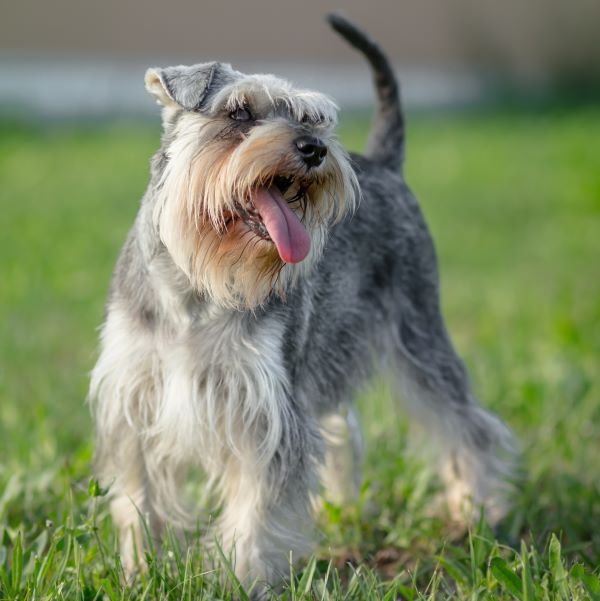
Breed history of Miniature Schnauzers
The Miniature Schnauzer was developed in Germany in the late 19th century as a smaller version of the Standard Schnauzer, to work as fearless barnyard ratters. Its ancestry also includes Affenpinscher and Poodle, and possibly Miniature Pinscher, Wire Fox Terrier and Zwergspitz.
Georg Riehl and Heinrich Schott are the men responsible for miniaturising the standard Schnauzer through cross breeding in Germany. Records show that the first Mini Schnauzer was listed in 1888 with the breed appearing in dog shows in 1899.
The Miniature Schnauzer is the ultimate rat catcher and was used around farms for this specific purpose, although it soon became a popular companion dog because of its friendly nature and alertness. Today, this dog is very popular right around the world and the Miniature Schnauzer regularly appears in the 20 top most popular dog lists globally.

Physical description of Miniature Schnauzers
The Miniature Schnauzer, the smallest of the three Schnauzer breeds, is a small, compact dog with a robust, sturdy frame. Its distinctive beard and bushy eyebrows give it an alert and intelligent expression.
Its square-shaped body is covered by a dense, double coat comprising a wiry topcoat and a soft undercoat. The Mini Schnauzer comes in three colours: salt and pepper, black and silver, and solid black.
| Weight range | 5 to 9 kg |
| Height range | 30 to 36 cm |
| Colours | Salt and pepper, black and silver, solid black |
| Coat length | Medium |
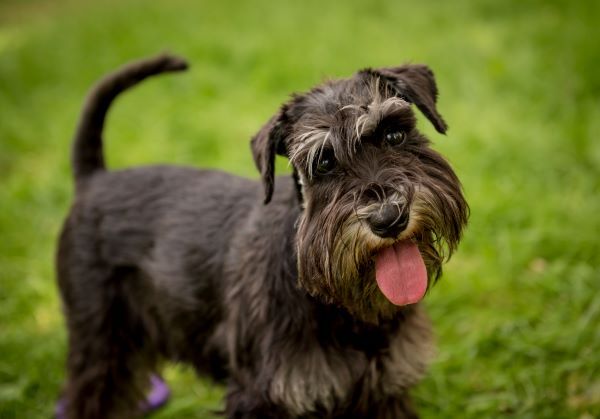
Miniature Schnauzer personality and temperament
The Miniature Schnauzer is a lively and engaging breed known for its friendly and affectionate nature. With a keen intelligence and a playful temperament, they are often described as having a larger-than-life personality packed into a small frame, and their alert and outgoing nature makes them an excellent choice for active households that can provide them with the mental and physical stimulation they thrive on..
Miniature Schnauzers are very much a family companion, forming strong bonds with their human family members. They are highly sociable dogs who enjoy close interaction with their family members, thriving in homes where they are included in daily activities. Whether it’s playing in the yard, lounging together, or accompanying you on outings, they love to be involved. They are not content being left alone for long periods and may become anxious or bored if neglected.
Mini Schnauzers fit well into various living environments, whether it’s a bustling city apartment or a more spacious rural home, as long as their needs for regular attention, interaction and exercise are met. While they enjoy daily outdoor walks and active play, they are also happy to curl up on the lounge for a nap with their owners.
Although Mini Schnauzers are very loyal towards their owners, they are not very obedient by nature. They have an innocent looking face but can actually be quite headstrong and mischievous. Because of this strong personality, it is important that they are well socialised and trained to understand their place in the home.
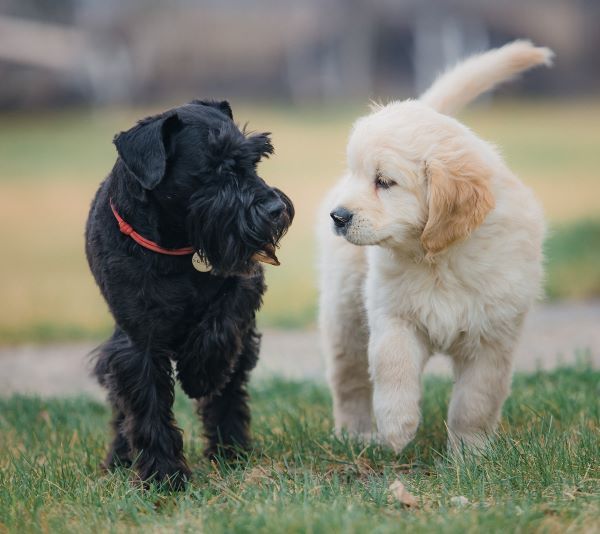
Miniature Schnauzers with kids and other pets
The Miniature Schnauzer is an excellent companion for families, especially those with children. Playful and affectionate by nature, they tend to form strong bonds with kids and enjoy being involved in family activities. Their friendly disposition makes them patient and tolerant, though their small size means they may be better suited for families with older children who understand how to interact with them gently.
As for other pets, Miniature Schnauzers are generally friendly but can be somewhat territorial due to their strong guarding instincts. They do well with other dogs, especially if they’ve been socialised from a young age. However, their inherent hunting instincts may cause them to chase smaller animals like cats or rabbits, so early socialisation is key to helping them adapt to multi-pet households.
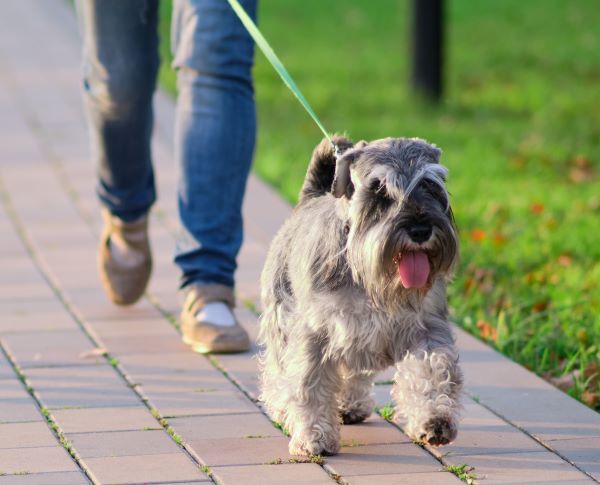
Miniature Schnauzer training and exercise
The Miniature Schnauzer is an energetic breed that thrives on regular physical exercise and mental stimulation. Although small in size, they are very active and require daily walks, playtime and interaction to keep them healthy and happy. Engaging activities like fetch, agility training, and even some light jogging are great for meeting their physical exercise needs.
A lack of sufficient exercise can lead to restlessness or undesirable behaviours, so it’s important to ensure they receive regular activity. Mini Schnauzers love to chase and catch things so always remember to keep the dog on a lead when out walking.
Although they are quick learners and highly sensitive to their owner’s needs, training a Miniature Schnauzer requires consistency and patience. They are intelligent dogs that are eager to please but they often have an independent streak, so positive reinforcement techniques work best, and training should involve mental challenges to keep them engaged. Training for lengthy periods of time is not encouraged because if there is too much repetition they can become bored. Early socialisation is essential to help them develop into well-rounded pets.
| Energy level | Medium to high |
| Exercise requirements | Moderate |

Miniature Schnauzer feeding and nutrition
The Miniature Schnauzer has specific dietary needs because of its active and agile nature. Providing high-quality food that is rich in protein, healthy fats, and essential nutrients helps maintain their muscular build, shiny coat, and overall well-being.
As Mini Schnauzers age, their nutritional requirements change. Puppies need a nutrient-rich diet to support growth and development, while adults require balanced meals that sustain energy levels without leading to weight gain. Senior dogs may benefit from lower-calorie foods with added joint-supporting supplements to address their changing metabolism and prevent obesity.
Managing calorie intake is crucial to avoid obesity, which can strain their joints and impact overall health. Regular mealtimes and portion control are essential for keeping them at a healthy weight. Consulting a veterinarian can ensure the right diet is provided based on the dog’s unique needs, whether it’s a growing puppy or an adult.
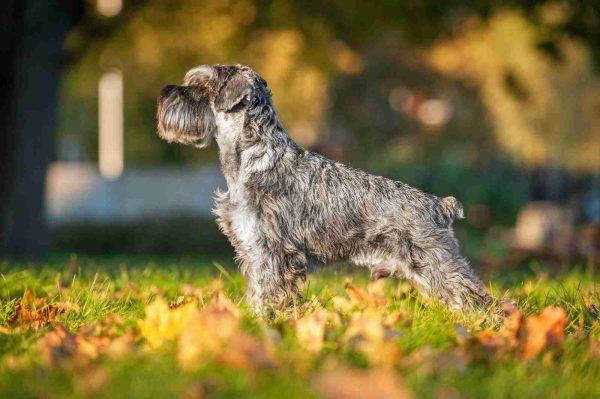
Miniature Schnauzer care and grooming
The Miniature Schnauzer has a very wiry coat that requires regular grooming to maintain its characteristic appearance. Their coat consists of a dense outer layer with a soft undercoat, and regular brushing is needed to prevent mats and tangles. This breed sheds minimally and is considered a good option for those with allergies.
The Mini Schnauzer’s coat is usually hand-stripped to preserve the natural texture, though some owners may opt for clipping. However, clipping can alter the coat’s feel and appearance. Regular trimming around the face, ears, and legs ensures the Schnauzer looks neat and tidy.
Bathing is necessary only every few months or when the dog gets particularly dirty. Regular nail trimming is essential and their ears should be cleaned regularly to avoid any infections, especially because of their floppy shape, which can trap dirt and moisture. Dental care is also vital; routine teeth brushing or professional cleanings will help prevent tartar buildup and keep their teeth and gums healthy.
Health issues for Miniature Schnauzers
- Cataracts, as for humans, refer to a cloudy membrane forming over the eye, causing vision impairment, and can eventually lead to blindness. They can be removed surgically.
- Entropion is a congenital condition in which the eyelids appear to roll inward against the cornea of the eye; this can cause a great deal of discomfort for the animal. While it usually occurs before the dog is one year old, it is best to wait till the dog reaches adulthood before considering corrective surgery.
- Progressive Retinal Atrophy (PRA) is an eye disease that can occur in Miniature Schnauzers. In most cases, the rods and cones of the retina deteriorate and are eventually worn away over a course of months or years, resulting in progressive vision loss and ultimately, blindness.
- Bladder Stones can occur in Miniature Schnauzers, which can cause discomfort, urinary issues, and in severe cases, blockages. Diet modification and plenty of water intake can help reduce the risk of bladder stones. Smaller stones can pass by themselves, but affected dogs should still see a vet.
- Hip Dysplasia, although less common in Miniature Schnauzers than in larger breeds, can occur. This condition involves the abnormal development of the hip joint, leading to pain, stiffness, and potential arthritis. Early detection and maintaining a healthy weight are essential to minimizing its impact and ensuring a good quality of life for the dog.
- Pancreatitis is an inflammation of the pancreas that can cause abdominal pain, vomiting, and loss of appetite. Miniature Schnauzers are more susceptible to pancreatitis, which can be managed by feeding a low-fat diet and avoiding table scraps, as well as regular veterinary monitoring.
- Legg-Calvé-Perthes Disease is a condition that affects the hip joint and results in the loss of blood supply to the femoral head, leading to pain and lameness. Legg-Calvé-Perthes disease is most common in smaller breeds like the Miniature Schnauzer and may require surgical intervention to manage the condition.
- Dental Disease can occur as Miniature Schnauzers are prone to dental issues, particularly tartar buildup, gum disease, and tooth loss. Regular dental care, including daily brushing and professional cleanings, is essential to prevent these problems and maintain oral health.
- Allergies can occur in Miniature Schnauzers, whether environmental, food-related, or from contact irritants. Symptoms can include itching, redness, and frequent scratching or licking. A vet can help identify and manage triggers with appropriate treatment options.
Not all conditions are covered by Pet Insurance. For details of Bow Wow Meow Pet Insurance cover, refer to the Product Disclosure Statement.
Thinking about insuring a Miniature Schnauzer
Thinking about insuring a Miniature Schnauzer
Learn moreThinking about insuring a Miniature Schnauzer
Learn moreFree engraved pet ID tag on sign up3
Customer Satisfaction
21 day cooling off
Easy to use Pet Portal

GapOnly® in vet claims
MORE INFORMATION
Miniature Schnauzer Club of NSW Inc: https://www.minischnauzerclub.com/
Schnauzer Club of NSW Inc: http://www.schnauzerclubnsw.org.au
Schnauzer Club of Victoria: https://schnauzerclubvic.com.au/

